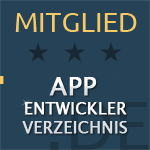
Insight

Insight

Insight
Optimize your app development with clean pull requests.


Julian Giesen
·
·
Monday, April 22, 2024


Julian Giesen
A Pull Request (PR) is an important tool that affects the quality and efficiency of team collaboration. A well-structured and clearly documented PR not only ensures that changes are transparent and easily traceable but also that potential issues can be identified and addressed early. This helps keep the codebase clean and avoids technical debt. Furthermore, clean PRs promote collaboration within the team by providing a clear framework for feedback and discussion. In short, well-presented Pull Requests are the foundation for successful and effective development of high-quality apps.
Creating Pull Requests
Creating solid PRs spans various levels of the development process and directly impacts the quality of the final product.
First of all, well-presented PRs provide clarity and transparency throughout the development process. Everyone in the team can easily understand what changes were made and why they were made. This not only fosters communication within the team but also makes it easier to identify bugs and potential improvements.
Furthermore, they promote effective collaboration in the team. With clear descriptions of the changes and their impacts, developers can more easily give and receive feedback. This enables open communication and helps the team work together on solutions rather than acting in isolation.
Finally, the traceability of changes and decisions improves throughout the development process. A clear commit history allows for detailed tracking of the development path and identification of potential issues. This is especially important when it comes to reverting changes or understanding the code for future developers (including oneself).
Preparing the Pull Request
Before a PR is created, it is important to conduct a thorough review of the changes made. This includes not only functionality but also adherence to coding standards and best practices.
Another important component is the writing of clear commit messages. A meaningful commit history helps track the development process. Each commit should contain a clear description of the changes made and their impacts. This not only facilitates collaboration within the team but also aids in identifying and resolving issues in the code.
By carefully preparing and documenting changes, developers can ensure that their PR is of high quality and offers value to the project. A clear and consistent commit history also makes it easier for other developers to understand the development path and quickly familiarize themselves with the code.
Best Practices for Creating Pull Requests
When creating Pull Requests, it is important to follow best practices to enhance the quality and effectiveness of the development process.
Firstly, a structured description of the changes made and their impacts is essential. This enables reviewers to quickly understand what was changed and why. A clear and precise description also helps other developers grasp the context and provide feedback.
Moreover, large PRs should be broken down into manageable units. Splitting them into smaller, logically connected parts reduces review time and decreases the likelihood of conflicts and errors. This fosters efficient collaboration within the team and makes it easier to implement changes incrementally.
Another central aspect is the documentation of important decisions and technical details. This can be done through comments in the code or additional descriptions in the PR. Clear documentation allows other developers to understand the rationale behind decisions and facilitates the maintenance and further development of the code.
Review Process and Feedback
Open communication within the team during the review process is extremely important. Through constructive discussions and clear feedback, potential issues can be identified and addressed early. This not only fosters a sense of collaboration but also helps all team members develop a shared understanding of the changes and decisions.
Giving and accepting constructive feedback is also crucial. Developers should strive to articulate their feedback clearly and precisely to avoid misunderstandings. At the same time, it is important to be open to feedback and view it as an opportunity for improvement. By being receptive to feedback and willing to learn from it, developers can continuously enhance their skills and contribute to the quality of the code.
Finally, the review process is an iterative process based on continuous feedback. Developers should be willing to make changes and improve their approach based on the feedback received. This fosters a culture of continuous improvement and ensures that the code is constantly optimized to meet requirements and standards.
Tools and Techniques for Support
First, code review tools like GitHub or GitLab provide a user-friendly platform for conducting code reviews. These tools allow developers to comment on changes, give feedback, and discuss the code. This facilitates a structured and transparent evaluation of the changes made.
Integrating automated tests and code analyses is another important aspect. Automated tests can identify and address potential bugs early, before the code goes into production. Code analysis tools help maintain best practices and coding standards and identify potential issues in the code.
Additionally, the use of style guides and code formatting rules is of great importance. Style guides define uniform guidelines for formatting and structuring code, improving its readability and maintainability. By adhering to code formatting rules, it is ensured that the code remains consistent and easily understandable, regardless of who reads or edits it.
Conclusion
First, it is important that PRs are clearly structured and described in detail. This allows reviewers to easily understand the changes and provide appropriate feedback.
A clean commit history is also essential to track the development process. Clear and meaningful commit messages help other developers understand the code and identify potential issues.
For large PRs, key points and decisions should be raised and documented. This makes it easier for other developers to understand the context and potentially give feedback or suggest adjustments.
Overall, well-presented PRs are a central component of an efficient and high-quality development process. By following these principles, developers contribute to improving collaboration in the team and developing high-quality apps.
All insights
All insights
“Flutter and the related logo are trademarks of Google LLC. We are not endorsed by or affiliated with Google LLC.”
“Flutter and the related logo are trademarks of Google LLC. We are not endorsed by or affiliated with Google LLC.”
Copyright ©2025. Julian Giesen. All rights reserved.
“Flutter and the related logo are trademarks of Google LLC. We are not endorsed by or affiliated with Google LLC.”






